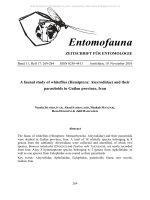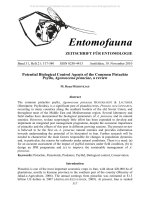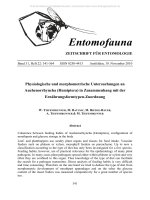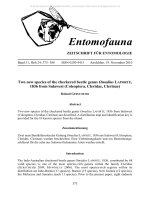Entomofauna, ZEITSCHRIFT FÜR ENTOMOLOGIE VOL 07-0201-0214
Bạn đang xem bản rút gọn của tài liệu. Xem và tải ngay bản đầy đủ của tài liệu tại đây (433.78 KB, 14 trang )
Bntomojauna
ZEITSCHRIFT FÜR ENTOMOLOGIE
Band 7, Heft 14
ISSN 0250-4413
Linz, 20.Mai 1986
New Symmocid and Holcopogonid Species
from the Eastern Mediterranean
(Lepidoptera; Symmocidae, Holcopogonidae)
Lancelot A. Gozmäny
Abstract
The description of the Symmocid Symmoca straminella sp.
n., Symmoca salinata sp.n., Amselina parapsestra sp. n.,
and Orpecovalva aphrodite sp.n. from Asia Minor and Cyprus, and of the Holcopogonid Arragonia anatolica sp.n.
from Anatolia. The synonymy of the generic taxa Amselina
GOZMANY,1957, and Eremicamima GOZMÄNY,1964.
Symmoca
straminella sp.n.
Alar expanse: 16 (exceptionally 18) mm. Antenna medium
grey, labial palpi whitish stramineous, second Joint
greyish externally. Head, thorax, scapulae, basic colour
of fore wing a light (somewhat greyish) stramineous;
fore wing with 2 dark brown spots at l/3, oblique,2 discoidals fused into a minute bar (composed of merely a
few yellowish brown scales), preapical blotch rather
201
large and diffuse, occasionally triangulär, a lighter
yellowish brown, pretornal blotch still more indistinct;
a narrow zone along termen irrorated with brownish scales, cilia there also slightly brownish, with a sharper
basal line, otherwise stramineous. Hind wing with cilia
whitish grey to stramineous white.
Male genitalia (fig.l): head of sacculus simple (without a recurrent inner membrane or flap), appendix short,
somewhat longer than its greatest width, transtillar lobe of same proportions; aedoeagal cornuti characteristically curved.
Holotypus male: "Syria sept. Taurus mer. Marasch 700900m 2.IX.1929 EINH.SLR.leg.", "Symmoca straminella gen.
prep.No."10" Dr.L.GOZMÄNY", preserved in the Zoologische
Staatssammlung München.
Paratypes: same locality,slide "8","13","26",preserved
in Munich; same locality, slides 1241, 1490, preserved
in the Hungarian Natural History Museum Budapest; same
locality, slides 1242, 1243> preserved in the Naturhistorisches Museum Wien; all specimens deriving from the
OSTHELDER Collection.
I first identified these specimens as Symmoea pyrrhella RAGONOT,l895 (GOZMÄNY 1962), but subsequent studies
revealed the presence of two distinct species. Symmoea
pyrrhella (= Symmoca zeitunella REBEL, 1902, also from
Asia Minor) is larger, 19-20 mm, and the fore wing also
displays a fine orange tint; in its male genitalia the
head of the sacculus has an inner, rucurrent membrane
and the cornuti are nearly straight (fig.2).
Symmoca salinata sp.n.
Alar expanse: 19-22 mm, a large species in this specific assembly. Antenna light fuscous, labial palpi stramineous, inside and outside darker, brownish. Head light
stramineous, thorax and scapulae greyish stramineous.
Basic colour of fore wing light greyish stramineous,
sparsely irrorated with dark fuscous brown,densest along
costa, in discocellular area and in apical third (there
indistinctly outlining veins), characteristic spots much
darker, brownish black, rather sharply defined: a cuneiform spot in cell at l/3, plical spot round and situated
202
below fold, discocellular large, discernibly fused from
two smaller spots, rotund; less dark and rather obscure
blotches beyond discocellular, at 2/3, in preapical and
pretornal positions, similarly dark and slightly triangulär marks indicating termination of veins along termen.
Hind wing medium raargaritaceous grey, cilia light Stramine ous .
Male genitalia (fig.3): head of sacculus with an inner,
recurrent membrane, appendix and transtillar lobe relatively long, aedoeagal cornuti straight or hardly arcuate.
Holotype male: "Asia min. Anatolien Eregli, Salzsteppe
4.9.-14.9.67. leg.M.u.W.GLASER", "Holotypus Symmoca salinata gen.prep.No.5126 Dr. L. GOZMANY11, deposited in the
Hungarian Natural History Museum, Budapest.
Paratypes: "SO-Türkei Salmanti 7-9.1947 leg.KOSSWIG",
3 males, two of them (slides 1515, 1516) preserved in
the DE LATTIN Collection, Saarbrücken, the third one,
with the additional label "Oecophoride (Palpen fehlend,
nicht bestimmbar) det.HERING 1958" (in HERING1s hand),
slide 5230, in the Hungarian Natural History Museum, Budapest] a male from "Asia min. Jozgat 24.-27.8.1975
FRIEDEL leg.", slide 5123, in the BURMANN Collection,
Innsbruck; and 7 males: "Türkei Prov. Konya Taurus, Sertavul gecidi löOOm leg.Gg.DERRA 3.9-1983", slide 5696,
preserved in the DERRA Collection,Bamberg, but 2 of them
in the Hungarian Natural History Museum, Budapest.
Externally the new species Stands nearest Symmoca forster i GOZMANY, 1963, (Iran), but its male genitalia lack
an appendix. The cornuti of S. pyrrhella are curved and
its appendix and transtillar lobe, as also those of S.
Straminella sp.n., above, are considerably shorter. The
three latter species from Asia Minor are easier to distinguish by their external (macroscopic) features: pyrrhella shows the unique orange tint,the pattern of straminella is very diffuse, that of salinata more clearly
defined and more extensive.
Amselina GOZMANY, 1957
Amselina GOZMANY, 1957, Annls.hist.-nat.Mus.natn.hung.,
S.N.8:337- Type species: Amselina olympi GOZMANY,
203
1957, ibid. 8:337, fig.7:H, by original designation.
Synonym: Eremicamima GOZMANY, 1964, Acta zool. hung. 10:
104. Type species: Symmoca cedestiella ZELLER ,1868,
Stettin.ent.Ztg. 29:140, by original designation.
A recent reappraisal of the holotype specimen of Amselina GOZM., and its comparison with the specimens representing the type species of Eremicamima G0ZM.,has shown
that the latter generic taxon cannot be upheld as
distinct against the former one, and is hereby dravm in
as a subjective junior synonym.
Amselina parapsesta sp.n.
Alar expanse: 14-17 nun. Externally indistinguishable
from Amselina emir (GOZMANY, 1961), comb.n.
Male genitalia (fig.4): valva with parallel sides (or
very nearly so); aedoeagus as long as sacculus.
Female genitalia (fig.5): ostium subconical, cervix
long.
Holotype male: "Asia min. Anatolia Kizilcahamam 4-149.67, leg.M.u.W. GLASER", "Holotypus Amselina parapsesta
gen.prep.No.5059 Dr.L.GOZMANY", preserved in the GLASER
Collection, Vienna.
Paratypes: same data, 2 males in the GLASER Collection,
Vienna; same data, slide 5043, in the Hungarian Natural
History Museum, Budapest; 21 males and 4 females, from
"Anatolia Kizilcahamam 700m 31-7.-1.8.63. leg.ARENBERGER", in the ARENBERGER and GLASER Collections, Vienna,
the
BURMANN
Collection,
Innsbruck
(slide
4041), and Budapest (slides 2832, 2833, 5042); 3 males
from "Asia min. Turcia Kizilcahamam 952m 18.6.-19.6.1968
leg.M.u.W.GLASER", in the GLASER Collection (slide 5384)
and in Budapest (slide 5380); 2 females from "Asia min.
Kizilcahamam 29-6.-2.7-1970. FRIEDEL", in the BURMANN
Collection, Innsbruck (slide 46OO) and Budapest (slide
4604); 5 males and 1 female from "Türkei Prov.Afyon 8km
östl. Emirdag 1050m 29.8.1983 leg.Gg.DERRA", slides 5719,
5720, preserved in the DERRA Collection, Bamberg and in
Budapest.
It is rather difficult to distinguish the new species
from Amselina emir (GOZMANY, 1961; comb.n.) (in 1968 I
204
published the Kizilcahamam series still as "Eremicamima
emir"), however, a painstaking study of series of specimens preclude their relegation to a Single specific taxon. On the average, the new species is larger (emir:
10/12-14/15 nun), the greyish irroration is denser and
the indistinct spots larger. In the genitalia of emir,
the valve is broadening toward its widely rounded apex,
the aedoeagus l/5 shorter than the sacculus, the female
cervix shorter (4-5 units against 5-5 in parapsesta) and
the ostium truncate or even finely concave. Until 1983 I
knew the new species only from Kizilcahamam, then DERRA
captured a series at Emirdag in South Turkey. It should
be noted that also A. cedestiella was taken at Kizilcahamam, but the genitalia of this latter species differ
much more conspicuously from those of the new one.
Orpecovalva aphrodite sp.n.
Alar expanse: 11-12 mm. Antenna medium grey, head white,
labial palpi greyish white, joints 2-3 with a dark grey
median ring; thorax and scapulae off-white, scapulae anteriorly dark grey. Fore wing narrow, chalk-white, pattern blackish brown: cellular and plical spots at l/3
near each other, oblique, parallel with connected discocellulars at 2/3; about 5-6 elongated marks around rather pointed apex (hence costa and termen subtending a
very sharp angle), a usually heavy dark irroration on
costa, in fold and apical area; preapical and pretornal
spots diffuse and displaced basad, that is, basally of
discocellulars (!). Fringe white, basally with grey scales and hairs. Female pattern diffuse but still discernible, basic colour more greyish (therefore darker than
in males!). Hind wing whitish grey, in female conspicuously dark grey.
Male genitalia (fig.6): Head of sacculus about as long
as basal section, resembling an elongated beak, nearly
straight (or its outer margin finely cancave when appressed in slide), appendix merely a short outer lobe of
costal fold, at level of saccular head; transtillar lobe
minute; aedoeagus about equal in size with entire valva
(even somewhat larger), cornuti minute, triangulär.
Female genitalia (fig.7): antrum oval, large, wide,
205
cervix about 2.5 times longer than ostium wide, therefore rather narrow, finely sclerotized, Signum large,
of the usual hat shape; ductus serainalis very wide, with
much scattered spinulae resembling thumb-tacks.
Holotype male: "Zypern, 19.-28.7-81 Troodos Gebirge
ndl. Troodos, 1500m M.u.E.ARENBERGER", "Holotypus Orpecovalva aphrodite gen.prep.No 5475 Dr.L.GOZMANY",preserved in the ARENBERGER Collection, Vienna.
Paratypes: 15 males and 10 females: same data, slides
5472, 5476, 5477;
9 females from "Zypern, 23.7-1981
Troodos Gebirge, Pedhoulas, 1000m", slides 5471, 5478;
and one female from "Zypern, 20.7.-1.8.1981 Troodos Gebirge Platres, 1200m"; the great majority preserved in
the ARENBERGER Collection, Vienna; 4 paratypes in the
Hungarian Natural History Museum, Budapest.
Externally the new species resembles 0. acantha (GOZMANY, 1963) from Sardinia, but it is still greyer, its
pattern even more obscure. As regards the genital configurations, there are no known near relatives: the minute
lobe of an appendix in the male and the peculiar shape
of the spinulae in the female separate the new species
from all congeners.
Arragonia anatolica sp.n.
Alar expanse: 23 mm. Antenna and head whitish stramineous, brush of second Joint of labial palpi white frontally and inside, brownish outside; thorax whitish, scapulae whitish stramineous. Basic colour of fore wing
stramineous, perceptibly deeper along and below costa
(to cell), then hardly discernibly, but still gradually,
tending to a lighter shade along dorsum; cell and fold
whitish, medially with some dark brown scales: more an
indistinct irroration than a definite longitudinal
"streak", heaviest at discocellular; some dark scales
present also between termination of veins in apical and
terminal areas; cilia whitish stramineous. Hind wing sericeous whitish yellow, cilia concolorous.
Male genitalia (fig.8): valval sides parallel, valva
terminally evenly rounded, margin whole, sacculus about
2/3 as long as valva, straight, apically finely incurved
and acuminate, transtilla attached to valva by convo206
lute and elongate folds; this area and sacculus setose;
saccus very long, slender; aedoeagus almost as long as
entire organ, simple, tubular, coecum much elongated,
resembling a spoon.
Holotype male: "Türkei Prov. Mersin Taurus 4 km NW Mut
300m 4.9.1983 leg. Gg. DERRA", "Arragonia anatolica gen.
prep.No.5711 det.L.GOZMANY", preserved in the DERRA Collection, Bamberg.
Paratypes: 2 males: "Türkei, Prov. Ankara, Tuz Gölü,
900m, 11.9-1983" (GU 5820 GOZMANY) and 2 males: "Türkei,
Prov. Nevsehir, Topuzdagi Gecidi, 20 km sö.Urzup, 1500m,
9.9.1983", all leg.G.DERRA, preserved in the DERRA Collection, Bamberg, and in the Hungarian Natural History
Museum, Budapest; 2 males: "Asia minor, Gürün, 28.8.-6.
9.1975, leg.FRIEDEL", 1 male: same, but 20.5.-20.7-,
leg.PINKER, preserved in Coll. EICHLER, Wittenberg;
1 male: "Asia minor, Tuz Gölü, Nordufer, 1000m, 9.-10.8.
1965", leg. et coll. ARENBERGER, Vienna.
The new species is the first representative of the genus in Asia Minor. In all other congeners, from Spain to
Tunesia, the sacculi are wider and/or the aedoeagi considerably thicker.
207
Figures (p. 209 - 213):
Fig. 1 - A: Symmoca straminella sp.n., paratype male,
from Marash, Anatolia, right transtillar lobe, appendix
and head of sacculus, slide 1242; - B: same, paratype
male, from same locality, appendix, heäd of sacculus and
cornuti, slide 1243; - C: same, paratype male, from same
locality, head of sacculus (in laterally imbedded position) and cornuti, slide 1241.
Fig. 2 - A: Symmoca zeitunella REBEL, 1902, holotype male, from Zeitun, Anatolia, left transtillar lobe, appendix and head of sacculus, slide 113; - B: Symmoca pyrrhella RAGONOT, 1895, holotype male, from Akbes, Syria,
left transtillar lobe, appendix and cornuti, slide 3013
(prep. VIETTE).
Fig. 3 - A: Symmoca salinata sp.n., paratype male, from
Taurus mts., Anatolia, right transtillar lobe, appendix,
left head of sacculus and cornuti, slide 5696; - B: same,
holotype male, from Eregli, Anatolia, cornuti and left
head of sacculus, slide 5126.
Fig. 4: Amselina parapsesta sp.n., paratype
Kizilcahamam, Anatolia, slide 5042.
male, from
Fig. 5 - A : Amselina parapsesta sp.n., paratype female,
from Kizilcahamam, Anatolia, slide 4604; - B: same, paratype female, from same locality and data, slide 46OO.
Fig. 6: Orpecovalva aphrodite sp.n., paratype male, from
Troodos, Cyprus, slide 5472.
Fig. 7- Orpecovalva aphrodite sp.n., paratype
from Pedhoulas, Cyprus, slide 5478.
Fig. 8: Arragonia anatolica sp.n., holotype
Mersin, Anatolia, slide 5711«
208
female,
male, from
o
209
210
211
212
213
Literatur
GOZMANY, L. - 1962. New and Interesting Symmocoid Species in the Zoological Collection of the Bavarian
State, Munich, Germany (Lep., Gelechiidae). - Opusc.
zool.Münch., 64:1-6.
GOZMANY, L. - 1967. The family Holpogonidae fam. nov.
(Lepidoptera) and its constituent taxa. - Acta
zool.hung., 13:271-278.
GOZMANY, L. - 1968. Die von E. Arenberger in Kleinasien
gesammelten Symmociden (Lepidoptera). - Z.wien.ent.
Ges., 53:20-28.
Manuskripteingang: 2.5-1985.
Author's address:
Dr. L. A. GOZMÄNY
Hungarian Natural History Museum
Baross u. 13
H-1088 Budapest
Hungary
214









